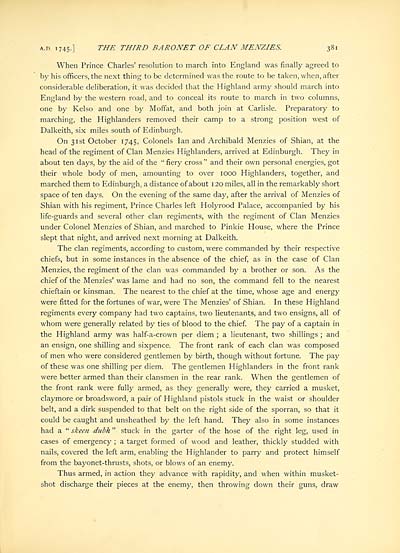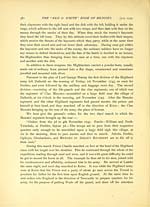Red and white book of Menzies
(481) Page 381
Download files
Complete book:
Individual page:
Thumbnail gallery: Grid view | List view

A.n 1745.] THE THIRD BARONET OF CLAN MENZIES. 381
When Prince Charles' resolution to march into England was finally agreed to
by his officers, the next thing to be determined was the route to be taken, when, after
considerable deliberation, it was decided that the Highland army should march into
England by the western road, and to conceal its route to march in two columns,
one by Kelso and one by Moffat, and both join at Carlisle. Preparatory to
marching, the Highlanders removed their camp to a strong position west of
Dalkeith, six miles south of Edinburgh.
On 31st October 1745, Colonels Ian and Archibald Menzies of Shian, at the
head of the regiment of Clan Menzies Highlanders, arrived at Edinburgh. They in
about ten days, by the aid of the " fiery cross " and their own personal energies, got
their whole body of men, amounting to over 1000 Highlanders, together, and
marched them to Edinburgh, a distance of about 1 20 miles, all in the remarkably short
space of ten days. On the evening of the same day, after the arrival of Menzies of
Shian with his regiment, Prince Charles left Holyrood Palace, accompanied by his
life-guards and several other clan regiments, with the regiment of Clan Menzies
under Colonel Menzies of Shian, and marched to Pinkie House, where the Prince
slept that night, and arrived next morning at Dalkeith.
The clan regiments, according to custom, were commanded by their respective
chiefs, but in some instances in the absence of the chief, as in the case of Clan
Menzies, the regiment of the clan was commanded by a brother or son. As the
chief of the Menzies' was lame and had no son, the command fell to the nearest
chieftain or kinsman. The nearest to the chief at the time, whose age and energy
were fitted for the fortunes of war, were The Menzies' of Shian. In these Highland
regiments every company had two captains, two lieutenants, and two ensigns, all of
whom were generally related by ties of blood to the chief. The pay of a captain in
the Highland army was half-a-crown per diem ; a lieutenant, two shillings ; and
an ensign, one shilling and sixpence. The front rank of each clan was composed
of men who were considered gentlemen by birth, though without fortune. The pay
of these was one shilling per diem. The gentlemen Highlanders in the front rank
were better armed than their clansmen in the rear rank. When the gentlemen of
the front rank were fully armed, as they generally were, they carried a musket,
claymore or broadsword, a pair of Highland pistols stuck in the waist or shoulder
belt, and a dirk suspended to that belt on the right side of the sporran, so that it
could be caught and unsheathed by the left hand. They also in some instances
had a " skeen dubh " stuck in the garter of the hose of the right leg, used in
cases of emergency ; a target formed of wood and leather, thickly studded with
nails, covered the left arm, enabling the Highlander to parry and protect himself
from the bayonet-thrusts, shots, or blows of an enemy.
Thus armed, in action they advance with rapidity, and when within musket-
shot discharge their pieces at the enemy, then throwing down their guns, draw
When Prince Charles' resolution to march into England was finally agreed to
by his officers, the next thing to be determined was the route to be taken, when, after
considerable deliberation, it was decided that the Highland army should march into
England by the western road, and to conceal its route to march in two columns,
one by Kelso and one by Moffat, and both join at Carlisle. Preparatory to
marching, the Highlanders removed their camp to a strong position west of
Dalkeith, six miles south of Edinburgh.
On 31st October 1745, Colonels Ian and Archibald Menzies of Shian, at the
head of the regiment of Clan Menzies Highlanders, arrived at Edinburgh. They in
about ten days, by the aid of the " fiery cross " and their own personal energies, got
their whole body of men, amounting to over 1000 Highlanders, together, and
marched them to Edinburgh, a distance of about 1 20 miles, all in the remarkably short
space of ten days. On the evening of the same day, after the arrival of Menzies of
Shian with his regiment, Prince Charles left Holyrood Palace, accompanied by his
life-guards and several other clan regiments, with the regiment of Clan Menzies
under Colonel Menzies of Shian, and marched to Pinkie House, where the Prince
slept that night, and arrived next morning at Dalkeith.
The clan regiments, according to custom, were commanded by their respective
chiefs, but in some instances in the absence of the chief, as in the case of Clan
Menzies, the regiment of the clan was commanded by a brother or son. As the
chief of the Menzies' was lame and had no son, the command fell to the nearest
chieftain or kinsman. The nearest to the chief at the time, whose age and energy
were fitted for the fortunes of war, were The Menzies' of Shian. In these Highland
regiments every company had two captains, two lieutenants, and two ensigns, all of
whom were generally related by ties of blood to the chief. The pay of a captain in
the Highland army was half-a-crown per diem ; a lieutenant, two shillings ; and
an ensign, one shilling and sixpence. The front rank of each clan was composed
of men who were considered gentlemen by birth, though without fortune. The pay
of these was one shilling per diem. The gentlemen Highlanders in the front rank
were better armed than their clansmen in the rear rank. When the gentlemen of
the front rank were fully armed, as they generally were, they carried a musket,
claymore or broadsword, a pair of Highland pistols stuck in the waist or shoulder
belt, and a dirk suspended to that belt on the right side of the sporran, so that it
could be caught and unsheathed by the left hand. They also in some instances
had a " skeen dubh " stuck in the garter of the hose of the right leg, used in
cases of emergency ; a target formed of wood and leather, thickly studded with
nails, covered the left arm, enabling the Highlander to parry and protect himself
from the bayonet-thrusts, shots, or blows of an enemy.
Thus armed, in action they advance with rapidity, and when within musket-
shot discharge their pieces at the enemy, then throwing down their guns, draw
Set display mode to:
![]() Universal Viewer |
Universal Viewer | ![]() Mirador |
Large image | Transcription
Mirador |
Large image | Transcription
Images and transcriptions on this page, including medium image downloads, may be used under the Creative Commons Attribution 4.0 International Licence unless otherwise stated. ![]()
| Histories of Scottish families > Red and white book of Menzies > (481) Page 381 |
|---|
| Permanent URL | https://digital.nls.uk/96658504 |
|---|
| Description | A selection of almost 400 printed items relating to the history of Scottish families, mostly dating from the 19th and early 20th centuries. Includes memoirs, genealogies and clan histories, with a few produced by emigrant families. The earliest family history goes back to AD 916. |
|---|

